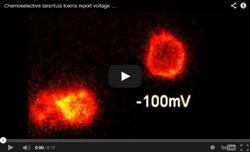Tarantula Toxin is Used to Report on Electrical Activity in Live Cells

The movie is quantitative imaging of cells with potassium channels, bathed in dilute fluorescent tarantula toxin. Pixel color indicates intensity of tarantula toxin concentration. The circular shapes are cell surfaces, illuminated by tarantula toxins bound to potassium channels. The cell on the right is electrically stimulated to the indicated voltages. The cells on the left remain at constant resting voltage. Intensity change reports activation of potassium channels. At -100 mV channels are at rest. During stimulus to 0 mV channels activate and fluorescence decreases as tarantula toxins fall off of potassium channels. Upon return to -100 mV, tarantula toxins find the resting channels again.
Crucial experiments to develop a novel probe of cellular electrical activity were conducted in the Neurobiology course at the Marine Biological Laboratory (MBL) in 2013. Today, that optical probe, which combines a tarantula toxin with a fluorescent compound, is introduced in a paper in the Proceedings of the National Academy of Sciences.
The lead authors of the paper are Drew C. Tilley of University of California-Davis and the late Kenneth Eum, who was a teaching assistant in the Neurobiology course and a Ph.D. candidate at UC-Davis.
The probe takes advantage of the potent ability of tarantula toxin to bind to electrically active cells, such as neurons, while the cells are in a resting state. The team discovered that a trace amount of toxin combined with a fluorescent compound would bind to a specific subset of voltage-activated proteins (Kv2-type potassium ion channels) in live cells. The probe lights up cell surfaces with this ion channel, and the fluorescent signal dims when the channel is activated by electrical signals.
This is the first time that researchers have been able to visually observe these ion channels “turning on” without first genetically modifying them. All that is required is a means to detect probe location, suggesting that related probes could potentially one day be used to map neural activity in the human brain.
“This is a demonstration, a prototype probe. But the promise is that we could use it to measure the activity state of the electrical system in an organism that has not been genetically compromised,” says senior author Jon Sack, an assistant professor in the departments of Physiology and Membrane Biology at UC-Davis. Sack is a faculty member in the MBL Neurobiology course.
Since the probe binds selectively to one of the many different kinds of ion channels, it can help scientists disentangle the function of those specific channels in neuronal signaling. This can, in turn, lead to the identification of drug targets for neurological diseases and disorders.
“We have an incredible diversity of ion channels, and even of voltage-activated ion channels. The real trouble has been determining which ones perform which roles. Which ones turn on and when in normal nervous system functioning? Which are involved in abnormal states or syndromes?” Sack says. “The dream is to be able to see what the different types of ion channels are doing and when, to understand what they contribute to physiology and pathophysiology.”
These probes respond to movement of ion channel voltage sensors, and it is particularly fulfilling to have conducted some of this work at the MBL, Sack says. The first measurements of voltage sensor movement were conducted at the MBL in the early 1970s by Clay M. Armstrong and Francisco Bezanilla (Nature 242: 459-461, 1973). Armstrong and Bezanilla used electrophysiological methods to measure the movement of voltage sensors. The spider toxin probe create an optical signal when voltage sensors move, and no electrophysiology or genetic mutation of the channels is required.
Citation:
Tilley DC, Eum KS, Fletcher-Taylor S, Austin DC, Dupré C, Patrón LA, Garcia RL, Yarov-Yarovoy V, Cohen BE, and Sack JT (2014) Chemoselective tarantula toxins report voltage activation of wild-type ion channels in live cells. PNAS doi: www.pnas.org/cgi/doi/10.1073/pnas.1406876111.
For more information, please see the UC-Davis press release.
Movie:
Recorded by Kenneth Eum, Lillian Patrón, and Christophe Dupré in the MBL Neurobiology course
The Marine Biological Laboratory (MBL) is dedicated to scientific discovery and improving the human condition through research and education in biology, biomedicine, and environmental science. Founded in Woods Hole, Massachusetts, in 1888, the MBL is a private, nonprofit institution and an affiliate of the University of Chicago.
Media Contact
All latest news from the category: Life Sciences and Chemistry
Articles and reports from the Life Sciences and chemistry area deal with applied and basic research into modern biology, chemistry and human medicine.
Valuable information can be found on a range of life sciences fields including bacteriology, biochemistry, bionics, bioinformatics, biophysics, biotechnology, genetics, geobotany, human biology, marine biology, microbiology, molecular biology, cellular biology, zoology, bioinorganic chemistry, microchemistry and environmental chemistry.
Newest articles

Properties of new materials for microchips
… can now be measured well. Reseachers of Delft University of Technology demonstrated measuring performance properties of ultrathin silicon membranes. Making ever smaller and more powerful chips requires new ultrathin…

Floating solar’s potential
… to support sustainable development by addressing climate, water, and energy goals holistically. A new study published this week in Nature Energy raises the potential for floating solar photovoltaics (FPV)…

Skyrmions move at record speeds
… a step towards the computing of the future. An international research team led by scientists from the CNRS1 has discovered that the magnetic nanobubbles2 known as skyrmions can be…





















